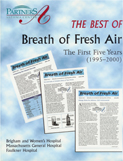Breath of Fresh Air: Feature Articles
Chapter 23: Sinusitis—A Primer
For many people with asthma, sinus disease can be an important — and undesirable — part of dealing with their asthma. Nasal congestion and sinus pressure can sometimes be almost as disabling as asthma itself, and active sinus disease may be a cause of worsening control of asthma. |
Allergies of the nose (allergic rhinitis) and of the bronchial tubes (asthma) commonly occur together. |
|
|
Allergies of the bronchial tubes (allergic asthma) manifest as wheezing, cough, and shortness of breath. Allergies of the nasal passageways (allergic rhinitis) cause runny nose, nasal congestion, mucus draining down the back of the throat ("post-nasal drip"), and sometimes loss of the sense of smell. The two disorders share a common origin, namely the tendency, called atopy, to make allergic reactions to certain substances in the air that we breathe. It is not surprising that allergic rhinitis and asthma commonly run together; in a sense, they are simply allergic reactions of two parts — the upper and lower portions — of our breathing passageways. The connection to sinusitis follows from congestion and swelling of the lining of the nose. The sinuses are air pockets in the bones of the skull, and our sinuses all connect to the outside air through passageways that open into the back of the nose. When the nose is inflamed and congested, drainage from the sinuses can get blocked. Pressure can build up within the sinus cavities, causing an aching pain in the head and sometimes the teeth. The location of pain is characteristic for the particular sinus cavities involved. For instance, the cheekbones hurt when the maxillary sinuses are inflamed, the forehead just above the eyes hurts when the frontal sinuses are affected, and the top of the head aches when there is involvement of the sphenoid sinuses. The pressure is often made worse by bending one's head down or blowing one's nose. Sinusitis literally means an inflammation of the sinuses, and the most common cause is a bacterial infection inside the sinus cavities. Germs can travel into the sinuses from the nose, get trapped there when the drainage passageway through the nose is blocked, and then cause pus-like mucus to accumulate in the sinuses. Blowing yellow or green mucus from the nose throughout the day is a sign of sinus infection, as the mucus from the infected sinus drains through the nose. |
Swollen nasal passageways predispose to sinusitis. |
|
|
The approach to treating sinus infections is two-fold. One part is the use of antibiotics to kill the germs that have collected within the sinuses. The other part is reducing the swelling within the nose so that the infected mucus can drain from the sinuses. Nasal decongestants used for this latter purpose include nasal sprays and decongestant tablets. Examples of effective nasal sprays include metolazone (Afrin®), neosynephrine, and ipratropium (Atrovent®) nasal spray. Oral decongestant tablets include pseudephedrine (Sudafed®) and phenylpropanolamine (present in many over-the-counter cold remedies). When the nasal congestion is caused by an allergic reaction more than by a cold (viral infection), antihistamines and nasal steroid sprays are also helpful to relieve allergic nasal swelling and promote sinus drainage. Over-the-counter salt water nasal sprays (nasal saline sprays such as Ocean® and Ayr®) help to rinse out allergens and irritants and to keep the lining of the nose moist. |
Treatment of sinusitis has two parts: Antibiotics to kill the germs, |
|
|
It is difficult for a doctor to determine the specific germ causing a particular sinus infection. Testing the mucus discharged from the nose does not provide reliable information about the germs growing in the sinus cavities. Definitive diagnosis would require surgical puncture into the sinuses themselves, a procedure that is fortunately generally unnecessary. Rather, antibiotics are chosen based on the usual germs known to cause sinusitis, influenced by any previous courses of antibiotics that one has received and by any individual history of medication intolerance or allergy. Many different effective antibiotics are available. |
It is difficult to determine the specific bacteria causing a sinus infection. | |
|
Persons who have had frequent recurrences of sinus infection or who have persistent, lingering ("chronic") sinusitis are often treated with prolonged (4-8 weeks) courses of antibiotics in an attempt to eliminate totally all germs from the sinuses. Occasionally, medical treatment fails because effective drainage of mucus from the sinuses cannot be achieved. One example occurs when the growth of excess tissue in the nose leads to the formation of nasal polyps that block the passage for drainage. A special scan (CT scan) of the sinuses may be useful in identifying the persistent accumulation of mucus in the sinuses despite attempts to drain them with medications. In this circumstance, surgery may be necessary to remove the polyps from the nose and to open larger drainage pathways from the sinuses. The pros and cons of sinus surgery for refractory sinusitis are best discussed in detail with your doctor, perhaps in consultation with an otolaryngologist (ENT surgeon). |
In recurrent or chronic sinusitis, sometimes surgery is needed to open dainage pathways. |

